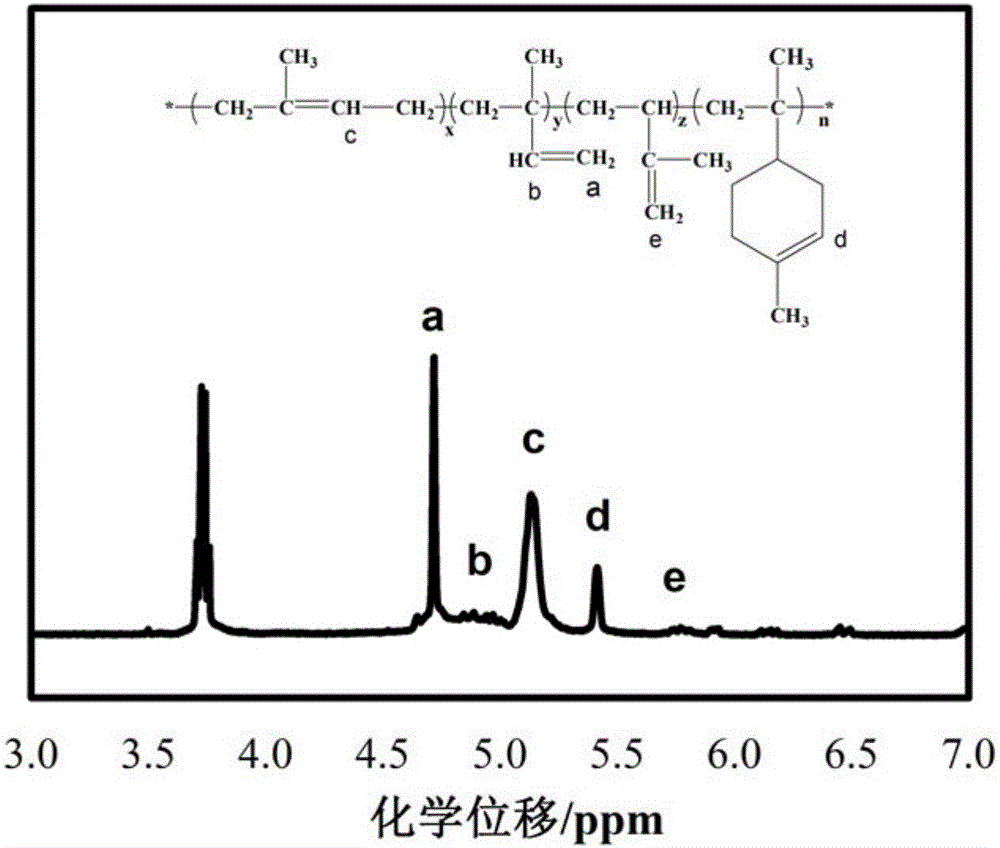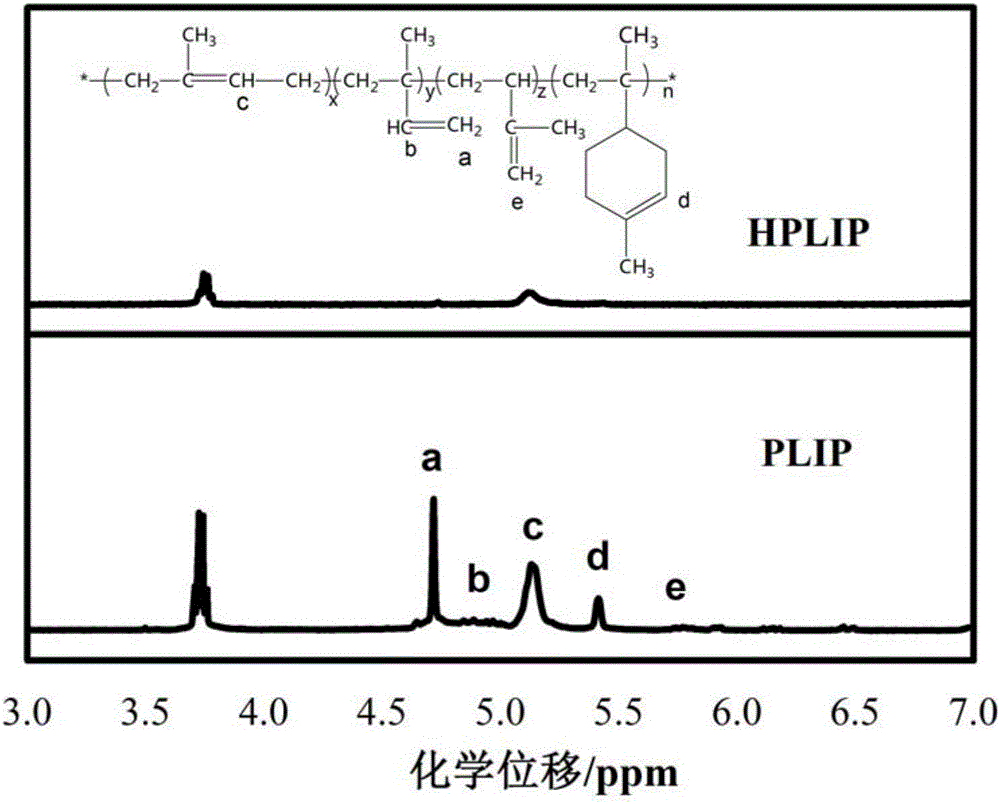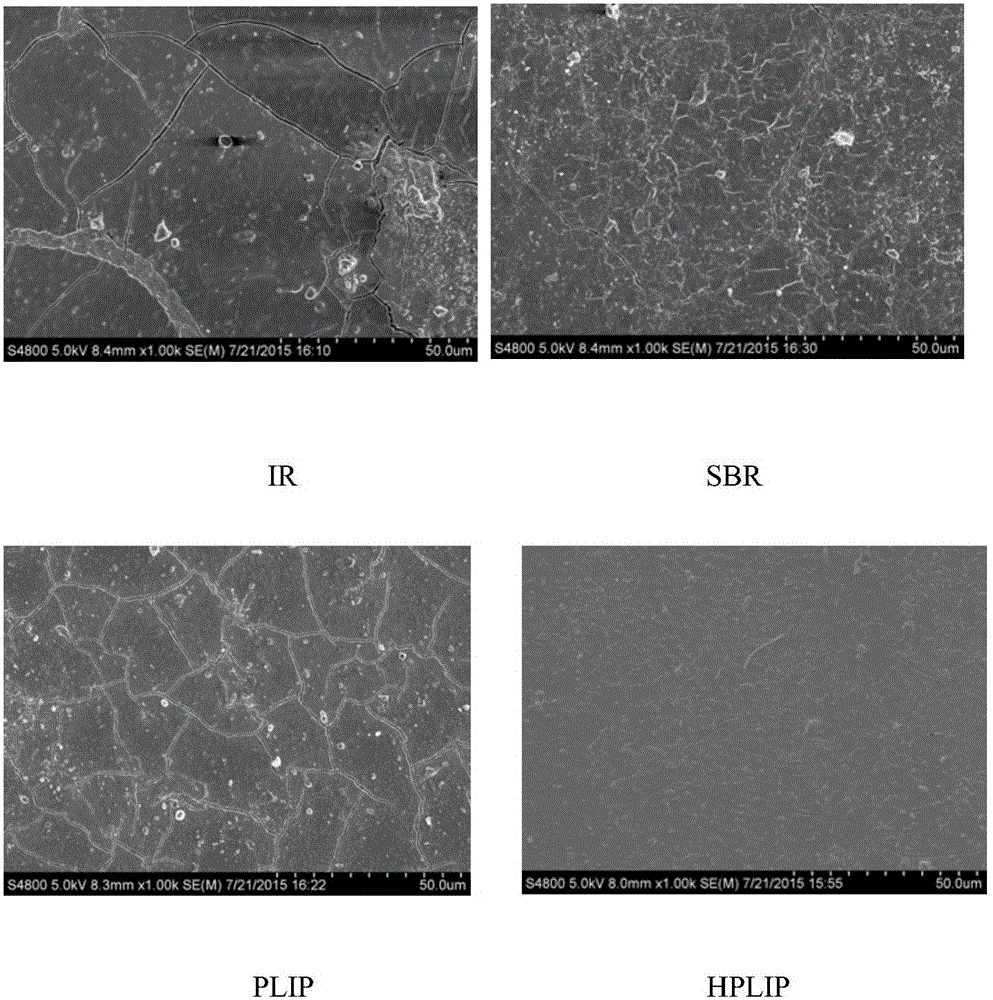Preparation method of limonene-isoprene antiwear rubber and obtained product
A technology of isoprene and wear-resistant rubber is applied in the field of preparation of isoprene binary rubber to achieve the effects of improving tensile properties, improving wear resistance and good wear resistance
- Summary
- Abstract
- Description
- Claims
- Application Information
AI Technical Summary
Problems solved by technology
Method used
Image
Examples
Embodiment 1
[0036] 1) Deionized water, emulsifier sodium dodecylbenzenesulfonate (SDBS), electrolytes KCl and K 3 PO 4 , monomer isoprene (IP) and limonene (LIM) are sequentially added into the pressure reactor to obtain a polymerization system.
[0037] Wherein, 250 g of deionized water was added, the total mass of the monomer was 100 g, and the mass ratio of isoprene (IP) to limonene (LIM) was 1:1. The added amount of SDBS accounts for 2% of the total mass of the monomer, the mass of potassium chloride accounts for 0.5% of the total mass of the monomer, and the mass of potassium phosphate accounts for 0.2% of the total mass of the monomer. The addition amount of the initiator potassium persulfate accounts for 0.2% of the total mass of the monomers.
[0038] 2) Treat the reactor containing the polymerization system with N 2 Evacuate 5 times to get rid of the air in the reactor. Then the reactor was heated to 30°C, the pressure inside it was adjusted to 1MPa, under N 2 Pre-emulsifica...
Embodiment 2-5
[0046] In order to study the effect of different feed ratios on the copolymerization product PLIP, the total number of monomers was selected as 100 parts, and the mass ratios of isoprene and limonene were 9:1, 8:2, 7:3, 6:4, and other reactions The conditions are: the total mass of the monomer is 100g, deionized water 250g, SDBS2g, KCl0.5g, K 3 PO 4 0.2g, K 2 S 2 o 8 0.25g.
[0047] Put the above polymerization system at 30℃ and 1MPa N 2 Pre-emulsify for 1 hour under atmosphere, then raise the temperature to 70° C., and react for 6 hours. After the reaction, the rubber was demulsified and coagulated with a calcium chloride solution with a concentration of 4 wt %, washed repeatedly with deionized water, and dried to obtain a copolymerized product.
[0048] Determination of the molecular weight and molecular weight distribution of PLIP, the test results are shown in Table 1, and the change of the copolymerization composition of PLIP with the feed ratio is shown in Table 2 ...
Embodiment 6-9
[0055] In order to study the effect of different initiator dosage on the copolymerization product, choose K 2 S 2 o 8 The dosage is 0.1g, 0.2g, 0.3, 0.5g.
[0056] Other reaction conditions are: deionized water 250g, SDBS2g, KCl0.5g, K 3 PO 4 0.2g, IP80g, LIM20g.
[0057] Put the above polymerization system at 30℃ and 1MPa N 2 Pre-emulsify for 1 hour under atmosphere, then raise the temperature to 70° C., and react for 6 hours. After the reaction, the rubber was demulsified and coagulated with a calcium chloride solution with a concentration of 2wt%, washed repeatedly with deionized water, and dried to obtain a copolymerized product, and the conversion rate was calculated. Measure the molecular weight of product with Gel Permeation Chromatography, and the results are shown in Table 3:
[0058] Table 3. Effect of initiator dosage on copolymerization product
[0059]
[0060] When the mass concentration of the initiator is 0.5%, the conversion rate of 95% can be reach...
PUM
 Login to View More
Login to View More Abstract
Description
Claims
Application Information
 Login to View More
Login to View More - R&D
- Intellectual Property
- Life Sciences
- Materials
- Tech Scout
- Unparalleled Data Quality
- Higher Quality Content
- 60% Fewer Hallucinations
Browse by: Latest US Patents, China's latest patents, Technical Efficacy Thesaurus, Application Domain, Technology Topic, Popular Technical Reports.
© 2025 PatSnap. All rights reserved.Legal|Privacy policy|Modern Slavery Act Transparency Statement|Sitemap|About US| Contact US: help@patsnap.com



